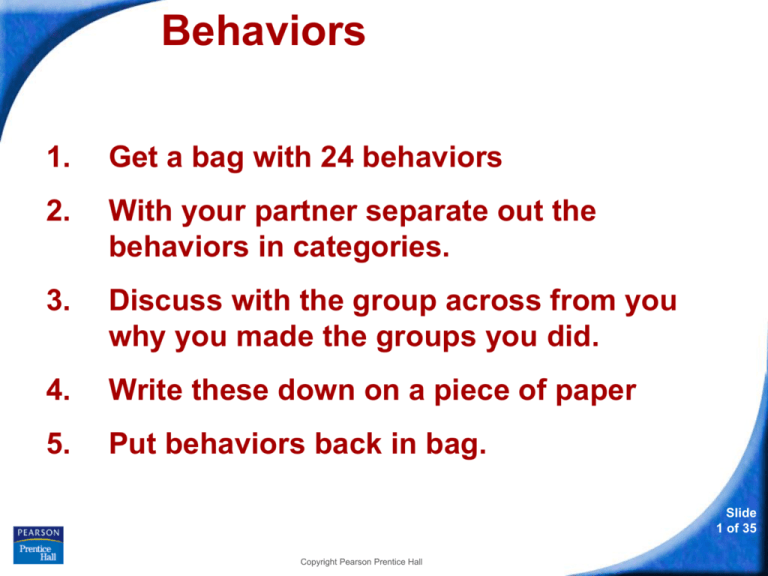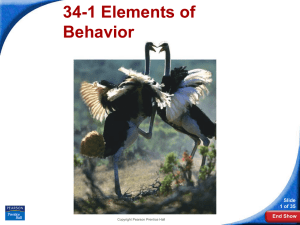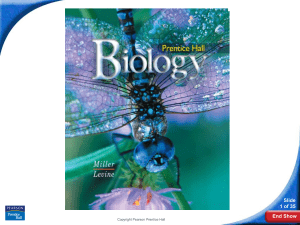
Behaviors
1.
Get a bag with 24 behaviors
2.
With your partner separate out the
behaviors in categories.
3.
Discuss with the group across from you
why you made the groups you did.
4.
Write these down on a piece of paper
5.
Put behaviors back in bag.
Slide
1 of 35
Copyright Pearson Prentice Hall
34-1 Elements of Behavior
Activity 1: Elements of Behavior 34-1
• Read sections 3, 4, 5, and 6
• Study the graphics and read ALL captions.
• Try to make personal connections!
Slide
2 of 35
Copyright Pearson Prentice Hall
34-1 Elements of Behavior
Innate and Learned Behaviors
Activity 2: Class Notes
1. Behavior and Evolution
• Animal behavior is important to survival and
reproduction.
• Many behaviors are influenced by genes and can
be inherited.
Reflexes
Innate Behaviors
Slide
3 of 35
Copyright Pearson Prentice Hall
34-1 Elements of Behavior
Innate and Learned Behavior
Behaviors can evolve under the influence of natural
selection.
• Organisms with an adaptive behavior will survive and
reproduce better than organisms that lack the behavior.
• These organisms have greater b_______ f_______.
(What’s the vocab word I’m looking for?)
• After natural selection has operated for many generations,
most individuals within the population will exhibit the adaptive
behavior.
Slide
4 of 35
Copyright Pearson Prentice Hall
34-1 Elements of Behavior
Innate and Learned Behavior
Innate Behavior = an instinct, or inborn behavior.
Behaviors appear in fully functional form the first time
they are performed, even though the animal may
have had no previous experience with the stimuli to
which it responds.
An instinct is NOT a reflex, which is a simple
response of an organism to a specific stimulus.
• contraction of the pupil in response to bright light
• movement of the lower leg when the knee is tapped.
Slide
5 of 35
Copyright Pearson Prentice Hall
34-1 Elements of Behavior
Innate Behavior
Innate behaviors depend on internal mechanisms
that develop from complex interactions between an
animal's genes and its environment.
Examples of innate behavior:
• the suckling of a newborn mammal
• the weaving of a spider web
Slide
6 of 35
Copyright Pearson Prentice Hall
34-1 Elements of Behavior
Learned Behavior
Learned Behavior
Many animals can alter their behavior based on
experience.
A change in behavior that results from experience
is called learning.
Learning is also called acquired behavior.
Slide
7 of 35
Copyright Pearson Prentice Hall
34-1 Elements of Behavior
Learned Behavior
The four major types of learning are:
• habituation
• classical conditioning
• operant conditioning
• insight learning
Slide
8 of 35
Copyright Pearson Prentice Hall
34-1 Elements of Behavior
Learned Behavior
Habituation
Habituation is a process by which an animal
decreases or stops its response to a repetitive
stimulus that neither rewards nor harms it.
For example, a worm may stop responding to the
shadow of something that neither provides the
worm with food nor threatens it.
By ignoring a nonthreatening or unrewarding
stimulus, animals can spend their time and energy
more efficiently.
Slide
9 of 35
Copyright Pearson Prentice Hall
34-1 Elements of Behavior
Learned Behavior
Classical Conditioning
Any time an animal makes a mental connection
between a stimulus and some kind of reward or
punishment, it has learned by classical
conditioning.
An example of classical conditioning is the work of
Pavlov and his dog.
http://www.youtube.com/watch?v=CpoLxEN54ho
Slide
10 of 35
Copyright Pearson Prentice Hall
34-1 Elements of Behavior
Learned Behavior
1. Before Conditioning
When a dog sees or
smells food, it produces
saliva.
Food is the stimulus and
the dog’s response is
salivation.
Dogs do not usually
salivate in response to
nonfood stimuli.
Slide
11 of 35
Copyright Pearson Prentice Hall
34-1 Elements of Behavior
Learned Behavior
2. During Conditioning
By ringing a bell every
time he fed the dog,
Pavlov trained the dog
to associate the sight
and smell of food with
the ringing bell.
Slide
12 of 35
Copyright Pearson Prentice Hall
34-1 Elements of Behavior
Learned Behavior
3. After Conditioning
When Pavlov rang a bell
in the absence of food,
the dog still salivated.
The dog was conditioned
to salivate in response to
a stimulus that it did not
normally associate with
food.
Slide
13 of 35
Copyright Pearson Prentice Hall
34-1 Elements of Behavior
Learned Behavior
Operant Conditioning
Operant conditioning occurs when an animal
learns to behave in a certain way through repeated
practice, in order to receive a reward or avoid
punishment.
Operant conditioning is also called trial-and-error
learning.
Slide
14 of 35
Copyright Pearson Prentice Hall
34-1 Elements of Behavior
Learned Behavior
Operant conditioning was first described by B. F.
Skinner.
Skinner invented a testing procedure using a
“Skinner box.”
A Skinner box has a colored button that, when
pressed, delivers a food reward.
After an animal is rewarded several times, it learns
that it gets food whenever it presses the button.
Slide
15 of 35
Copyright Pearson Prentice Hall
34-1 Elements of Behavior
Learned Behavior
Insight Learning
Insight learning, or reasoning, occurs when an
animal applies something it has already learned to
a new situation, without a period of trial and error.
Insight learning is common among humans and
primates.
If you are given a math problem on an exam, you
use insight learning in order to solve it.
Slide
16 of 35
Copyright Pearson Prentice Hall
34-1 Elements of Behavior
Instinct and Learning Combined
Instinct and Learning Combined
Most behaviors are a combination of instinct and
learning.
Young white-crowned sparrows have an innate
ability to recognize their own species’ song. To
sing the complete version, the young birds must
first hear it sung by adults.
Slide
17 of 35
Copyright Pearson Prentice Hall
34-1 Elements of Behavior
Instinct and Learning Combined
Some young animals learn to recognize and follow
the first moving object they see during an early time
in their lives. This process is called imprinting.
Imprinting keeps young animals close to their mother,
who protects them and leads them to food.
Once imprinting occurs, the behavior cannot be
changed.
Slide
18 of 35
Copyright Pearson Prentice Hall
34-1 Elements of Behavior
Instinct and Learning Combined
Imprinting can occur through scent as well as sight.
Salmon imprint on the odor of the stream in which
they hatch. When they are mature, salmon remember
the odor of the stream and return there to spawn.
Slide
19 of 35
Copyright Pearson Prentice Hall
34-1 Elements of Behavior
1. Review the groups of behaviors you made at the
beginning of class.
2. Do you want to make any changes? – Do so now
if you do.
3. Discuss with the group across from you why you
made the changes you did.
Slide
20 of 35
Copyright Pearson Prentice Hall
34-1 Elements of Behavior
Slide
21 of 35
Copyright Pearson Prentice Hall









